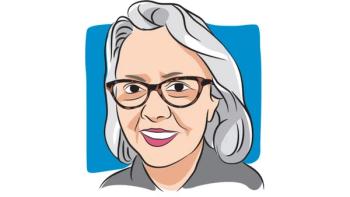Keytruda (pembrolizumab) continued to improve survival versus Yervoy (ipilimumab) in patients with unresectable stage 3 or 4 melanoma, as demonstrated by 10-year follow-up data from the phase 3 study KEYNOTE-006 study presented at the 2024 ESMO Congress.
Eligible patients were able to transition to the open-label phase 3 KEYNOTE-587 extension study, which was designed to continue collecting long-term efficacy in those with solid tumors who received prior Keytruda in a clinical trial. The median time from KEYNOTE-006 entry to KEYNOTE-587 data cutoff was 123.7 months.
Study Highlights:
- A 10-year follow-up data from the KEYNOTE-006 study showed that Keytruda continued to outperform Yervoy in terms of overall survival, progression-free survival, and melanoma-specific survival for patients with advanced melanoma.
- Patients who received Keytruda had significantly higher survival rates compared with those who received Yervoy. This includes an overall survival rate of 34% at 10 years for Keytruda compared to 23.6% for Yervoy.
- The study found that patients who responded well to Keytruda had excellent long-term outcomes, regardless of their initial disease severity.
- Even after patients stopped taking Keytruda, the benefits continued to be evident, with many patients remaining disease-free for extended periods.
- For patients whose disease progressed after the first course of Keytruda, a second course demonstrated promising results, with a significant number achieving responses.
Patients who received Keytruda (159 patients) experienced a median overall survival (OS; the time from the start of treatment when a patient with cancer is still alive) of 32.7 months versus 15.9 months with Yervoy (52 patients). The eight- and 10-year OS rates in the Keytruda group were 36.9% and 34%; in the Yervoy group, these rates were 24.8% and 23.6%.
The modified median progression-free survival (PFS; how long a person lives without their disease getting worse) with Keytruda was 9.4 months versus 3.8 months with Yervoy. The PFS rates at eight and 10 years in the Keytruda group were 23.4% and 22%; in the Yervoy group, these respective rates were 12.8% and 12.8%. The median melanoma-specific survival (MSS; how long a patient with melanoma lives) with Keytruda was 51.9 months versus 17.2 months with Yervoy. The eight- and 10-year MSS rates in the Keytruda group were 46.5% and 45.2%; these rates were 32.1% and 31.3% in the Yervoy group.
“With this 10-year follow-up, we have an OS rate of 34% but a MSS rate of 45.2%. We have a very good outcome for patients who responded or who had the benefit to the first course, and again, it shows that response is actually the best marker for long-term outcome. Unfortunately, we cannot know before [treatment] who is going to respond, but the patients who respond really do very well,” Dr. Caroline Robert, of Gustave Roussy and Paris-Saclay University, in Villejuif, France, said in a presentation of the data. “We [also] show that we have an additional activity that is quite significant for patients who are rechallenged if they had the benefit in the first course of [Keytruda]. I also would like to remind you of the safety. We all know that the grade 3 and above [side] effects with a single[-agent] regimen is around 15% to 20%, which is far below what we can see with a combination.”
KEYNOTE-006 enrolled patients with unresectable stage 3 or 4 melanoma not amenable to local therapy who had at least one measurable lesion. Patients were at least 18 years of age, had an ECOG performance status of 0 (fully active) or 1 (limited activity), and known BRAF mutational status. They could have received up to one prior systemic treatment as long as it was not an anti–CTLA-4, PD-1, PD-L1, or PD-L1 agent. Those with uveal or ocular melanoma or with known central nervous system metastases were excluded. Notably, patients with previously treated, stable (neither grows nor shrinks) brain metastases were permitted. Any patients enrolled in this trial who received study treatment or were in the survival follow-up phase of the research were able to transition to the extension study.
In KEYNOTE-006, participants were randomly assigned to receive Keytruda every two weeks up to two years, Keytruda every three weeks up to two years or Yervoy every three weeks for four cycles.
Those who experienced a complete response (CR; when a person's disease cannot be detected by any tests or examinations), which had been confirmed on two scans at least four weeks apart, were able to stop treatment, as long as they received Keytruda for six months or more and had received two or more doses of the agent beyond achievement of CR. Patients who experienced stable disease (SD; the tumor neither grows nor shrinks) or better during the first course of treatment with Keytruda were able to receive a second course every three weeks for up to one year or approximately 17 cycles while in either trial if they experienced progressive disease after discontinuing therapy.
In KEYNOTE-006, investigators evaluated tumor response via CT and MRI scans at week 12; this was subsequently done every six weeks through week 48, and every 12 weeks thereafter. Once treatment was stopped, participants were monitored for survival every 12 weeks until the end of the trial. Those who transitioned to the KEYNOTE-587 study were then followed for long-term survival, progressive disease and initiation of next anti-cancer treatment. Moreover, those who receive a second course of Keytruda in the extension trial were also followed for assessment.
The primary focus of this trial was OS. Exploratory areas of interest included PFS and PFS on the second course of Keytruda. Investigators conducted analyses that examined MSS in the overall population, OS in subsets, OS and modified PFS from week 94 in those who received at least 94 weeks of Keytruda, and more.
Of those assigned to Keytruda treatment in KEYNOTE-006 (556 patients), 228 were eligible to transition to KEYNOTE-587, and 159 were enrolled in the trial. Of the 278 patients assigned to the Yervoy group on KEYNOTE-006, 105 were able to enroll in the extension trial and 52 did so.
Keytruda continued to show superiority over Yervoy with regard to OS outcomes across all subgroups analyzed, including those with elevated lactate dehydrogenase levels (indication of tissue damage and some types of cancer; 270 patients), those with large tumors defined as at least 10 centimeters (186 patients) and those with brain metastases (80 patients).
In those who completed at least 94 weeks of treatment with Keytruda (103 patients), and with a median follow-up duration of 122.9 months, the median OS from week 94 was not reached (meaning half of the patients in the study were alive at the time researchers assessed this); the six- and eight-year OS rates from week 94 were 91.8% and 80%, respectively. The median modified PFS in those who completed 94 weeks or more of Keytruda was also not reached (meaning that half of the patients in the study had not experienced disease progression at the time data were analyzed); the six- and eight-year modified PFS rates from week 94 were 73.2% and 64.8%, respectively.
Of the patients who received a second course of Keytruda in either trial (16 patients), five achieved a CR, five experienced a partial response (decrease in tumor size or extent of cancer), four had SD, and two experienced disease progression. The median modified PFS from the start of the second course of Keytruda was 51.8 months; four- and six-year modified PFS rates from the start of the second course were 56.3% and 49.2%, respectively.
Of the overall population (556 patients), 66.2% of those who received Keytruda and 65.1% of those given Yervoy received the agents in the first-line setting. In these patients, the median OS with Keytruda or Yervoy was 38.7 months and 17.2 months. The respective 8-year OS rates were 40.1% and 27%; the 10-year OS rates were 36.9% and 25%. The median modified PFS in these patients who received Keytruda or Yervoy as first-line treatment was 12 months and 4.1 months. The eight- and 10-year modified PFS rates were 27% and 25.5% with Keytruda and 15.1% and 15.1% with Yervoy.
“These results confirm that Keytruda provides long-term benefit in patients with advanced melanoma, supporting it as a standard of care in this setting,” the study authors conclude.
For more news on cancer updates, research and education, don’t forget to subscribe to CURE®’s newsletters here.





